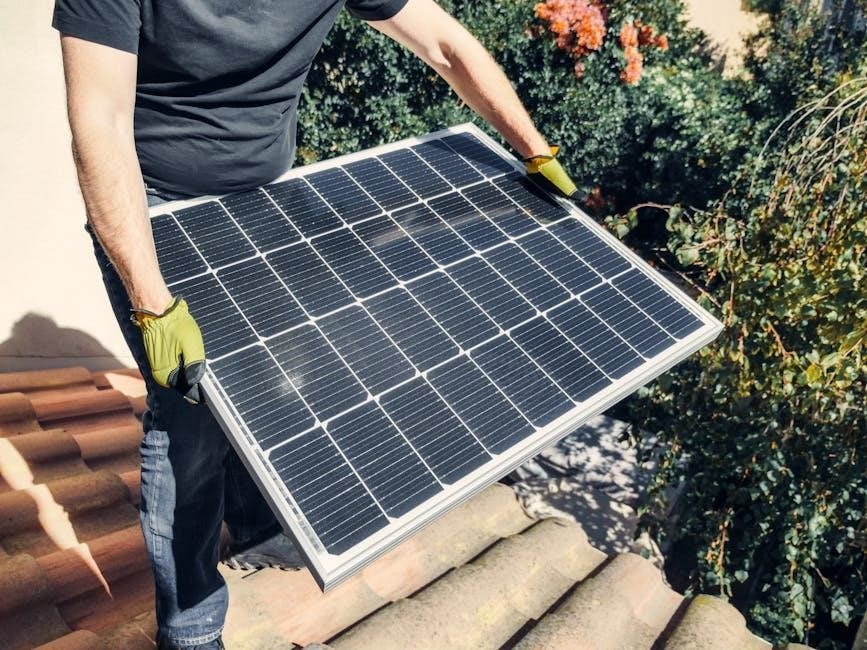The Viper 5706V is a remote start and car alarm system designed for vehicles, offering advanced security features and convenience. Directed Electronics manufactures this popular system, ideal for cold climates, allowing users to start their car remotely and warm it up before driving. Its user-friendly interface and robust functionality make it a preferred choice for vehicle owners seeking enhanced protection and comfort.

System Requirements and Compatibility
The Viper 5706V system is compatible with most vehicles but should not be installed in convertibles with manual transmissions due to potential risks and interference.
2.1. Compatible Vehicle Types
The Viper 5706V system is designed for most vehicles but is not recommended for convertibles with manual transmissions due to potential risks. It is compatible with a wide range of cars, trucks, and SUVs, provided they meet the system’s electrical and mechanical requirements. Installation in soft-top or hard-top convertibles with manual transmissions is strongly discouraged to avoid interference or malfunction. Always consult the installation guide for specific vehicle compatibility before proceeding.
2.2. Necessary Tools and Materials
Installing the Viper 5706V requires specific tools and materials, including wiring harnesses, connectors, and relay modules. A multimeter and soldering iron are essential for proper connections. For manual transmission vehicles, a bypass module like the Fortin INT SL may be needed. Ensure all components are compatible with your vehicle’s electrical system. Consult the installation guide for a detailed list of required tools and materials to ensure a successful setup.

Installation Process Overview
Installation of the Viper 5706V involves connecting the main harness, sensors, and modules. Ensure all components are securely wired and test the system post-installation for functionality.
3.1. Pre-Installation Checks
Before installing the Viper 5706V, ensure compatibility with your vehicle type, especially for manual transmissions. Review the installation manual thoroughly and verify all components are included. Check the vehicle’s electrical system and battery health. Ensure the parking brake is functional and test the remote start feature in a safe environment. Confirm the system’s programming requirements, such as MTS mode for manual transmissions, and ensure all safety precautions are understood.
3.2. Step-by-Step Installation Guide
Begin by reviewing the installation manual thoroughly. Disconnect the vehicle’s battery to ensure safety. Connect the main harness to the vehicle’s electrical system, following the wiring diagram. Install the sensors and modules, ensuring proper placement and alignment. Program the remote start feature by performing the Virtual Tach setup. Test the system to confirm all functions operate correctly. Finally, reconnect the battery and conduct a final test drive to verify proper operation.
Wiring Diagram and Connections
The wiring diagram outlines connections for the main harness, sensors, and remote start. Ensure all wires are securely connected to the correct pins and vehicle systems; Consult the manual for specific pinouts and configurations to avoid errors during installation.
4.1. Main Harness and Connector Pinouts
The main harness includes a 12-pin connector, with each pin designated for specific functions such as power, ground, ignition, and starter inputs. Refer to the wiring diagram for precise pin assignments to ensure correct connections. Improper wiring can lead to system malfunctions or damage. Always consult the installation manual for detailed pinouts and configurations, and verify connections before powering up the system. Directed Electronics recommends double-checking all wiring to avoid issues.
4.2. Sensor and Module Wiring
Proper wiring of sensors and modules is crucial for the Viper 5706V system’s functionality. The shock sensor connects to the main harness to detect impacts, while door and hood triggers ensure accurate alarm activation. The temperature sensor integrates with remote start to display interior temperature. Use the provided wiring diagram to connect these components securely. Ensure all connections are tight and insulated to avoid interference. Refer to the installation manual for specific module pinouts and wiring routes to prevent damage or malfunctions.

Remote Start Configuration
The Viper 5706V remote start requires proper configuration for seamless operation. Virtual Tach programming ensures engine start compatibility, while Manual Transmission Start Mode activates defogger and temperature display. Follow the installation guide for precise setup and testing to ensure reliable remote start functionality.
5.1. Programming the Virtual Tach
Programming the Virtual Tach on the Viper 5706V ensures proper engine synchronization. Start by remote starting the engine; the system may require up to three crank cycles for initial setup. Follow the installation guide to complete the process, ensuring accurate RPM detection. Proper configuration is essential for reliable remote start functionality, especially in vehicles with manual transmissions requiring MTS Mode activation. Always test the system post-programming to confirm performance.
5.2. Manual Transmission Start Mode
For manual transmission vehicles, the Viper 5706V requires Manual Transmission Start (MTS) Mode to be enabled when parking. This ensures the system recognizes the vehicle’s gear state, preventing accidental starts in gear. After setting MTS Mode, test the remote start function to confirm proper operation. Always ensure the vehicle is in park or neutral before remote starting. Proper configuration is critical for safe and reliable performance.

Troubleshooting Common Issues
This section addresses common issues with the Viper 5706V, such as the system not starting the engine or the remote not responding. Check wiring connections and consult the manual for solutions.
6.1. System Not Starting the Engine
If the Viper 5706V fails to start the engine, check the wiring connections for integrity and ensure the battery is fully charged. Verify that the Virtual Tach is properly programmed, as incorrect settings can prevent engine startup. For manual transmissions, confirm that the Manual Transmission Start (MTS) mode is enabled and configured correctly. Consult the installation manual or contact Directed Electronics support at 1-800-753-0600 for further assistance.
6.2. Remote Not Responding
If the remote fails to respond, ensure the battery is charged or replaced. Check for proper wiring connections and verify that the system is correctly programmed. Test the remote’s range and eliminate potential interference sources. Reprogram the remote if necessary, following the manual’s instructions. If issues persist, consult the Viper 5706V installation manual or contact Directed Electronics support for further troubleshooting assistance.
Safety Precautions and Warnings
Always follow safety guidelines during installation to avoid damage or injury. Ensure proper grounding and avoid installing in convertibles with manual transmissions. Never bypass safety features or tamper with critical systems, as this could lead to fire hazards or malfunctions. Adhere strictly to the Viper 5706V installation manual and consult authorized dealers if unsure.
7.1. General Installation Safety
Ensure proper grounding to prevent electrical shock or system damage. Disconnect the battery before starting installation to avoid short circuits. Avoid installing in convertibles or manual transmission vehicles without proper MTS Mode setup. Keep flammable materials away and never bypass safety features. Follow the Viper 5706V manual guidelines strictly to prevent fire hazards or malfunctions. If unsure, consult an authorized Directed Electronics dealer for assistance.
7.2. Remote Start Safety Considerations
Always conduct remote start safety checks to ensure the vehicle is parked in a well-ventilated area. Avoid starting the engine in enclosed spaces to prevent carbon monoxide buildup. Ensure proper Manual Transmission Start (MTS) mode setup for manual vehicles to prevent accidental movement. Never remote start the vehicle near flammable materials or open flames. Follow all instructions in the Viper 5706V manual to maintain safety and system functionality.
Additional Features and Adjustments
The Viper 5706V system offers a vehicle interior temperature display and a shock sensor adjustment. These features enhance convenience and security, ensuring optimal performance and user satisfaction.
8.1. Vehicle Interior Temperature Display
The Viper 5706V system includes a feature to display the vehicle’s interior temperature during remote start. This feature activates when the engine is started remotely, providing users with real-time temperature information. It enhances comfort by allowing drivers to warm or cool their vehicle before entry. The temperature display is particularly useful in extreme weather conditions, ensuring a pleasant in-cabin environment. This feature is automatically enabled during remote start mode and does not require additional adjustments.
8.2. Adjusting the Shock Sensor
The Viper 5706V system includes a shock sensor to detect impacts on the vehicle. To adjust the sensor, disarm the system and locate the trim pot on the sensor. Turn the pot clockwise to increase sensitivity or counterclockwise to reduce it. This adjustment ensures the sensor accurately detects impacts without triggering false alarms. Proper calibration is essential for reliable security performance and minimizing unnecessary alerts. Follow the manual for precise steps to fine-tune the sensor for optimal functionality.
User Manual and Documentation
The Viper 5706V user manual provides detailed installation and operation guides. It includes wiring diagrams, troubleshooting tips, and system features. Download the PDF from Directed Electronics’ official website or contact their support for assistance.
9.1. Owner’s Guide Summary
The Viper 5706V Owner’s Guide provides a concise overview of system operation, including remote start setup, security features, and troubleshooting. It details how to use the remote, program settings, and understand alert notifications. The guide also covers basic installation steps, wiring connections, and safety precautions. Directed Electronics emphasizes proper installation by authorized dealers for optimal performance. Users can download the PDF manual from official sources or contact support for further assistance, ensuring smooth functionality and user satisfaction.
9.2. Directed Electronics Support Contact
For assistance with the Viper 5706V system, users can contact Directed Electronics directly at 1-800-753-0600. The company provides comprehensive support, including troubleshooting, installation guidance, and answers to technical questions. Additionally, the official website offers downloadable resources, such as manuals and installation guides, to ensure optimal system performance and user satisfaction.
After installation, test the remote start functionality, verify all alarm features, and ensure proper wiring connections. Confirm system programming aligns with your vehicle’s specifications for optimal performance.
10.1. Post-Installation Testing
After completing the installation, perform a thorough test of the Viper 5706V system. Start by testing the remote start functionality, ensuring the engine turns on and runs smoothly. Verify all alarm features, including door triggers, shock sensor, and panic mode. Check the wiring connections for stability and ensure no electrical interference. Test the manual transmission start mode if applicable, and confirm the system’s response to remote commands. Finally, review the owner’s guide to ensure all settings are properly configured for optimal performance and security.
10.2. Maintenance Tips
Regularly inspect the system’s wiring and connections to ensure they are secure and free from damage. Check the remote control batteries and replace them as needed. Periodically test the alarm and remote start functions to ensure proper operation. Clean the shock sensor to maintain sensitivity and accuracy. Update the system’s software if new firmware is available. Perform annual checks of the wiring harness and connectors to prevent corrosion or wear.
